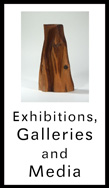


When
it comes to wood sculpting, Pierre Woog has an unusual modus operandi.
In his quiet workshop he sets a piece of wood on his worktable and looks
it over carefully. “If I listen,” he says, “the wood
talks to me.”
Curiosity aroused. We ask: “What does the wood say?” Woog
looks up. “It tells me what to do with my chisel and scraping
tools to bring out its inherent beauty.” He demonstrates his technique.
The skilled craftsman positions his chisel precisely, and raises his
hammer. Wham! One deft stroke and a fragment is chipped off, revealing
a curve in the wood. Just what he was hoping for. “Most of my
pieces are curves – for meditation,” says Woog. “As
I sculpt, I’m patiently mindful of contours. I want to bring them
out in flowing and complex ways to reveal their graceful shapes and
subtle changes in color.I have only one over-arching rule,” Woog
continues,“Don’t go against the grain. To violate the grain
would be to destroy the integrity, dignity and soul of the wood.”
It’s important to Woog that his sculptures are pleasing to the
eye and feel good to the touch. “I take a finger and follow the
contours. They’re smooth and sensual, vital…I can feel the
contours speak to me.” The artist never paints his pieces. Instead,
he coats them with beeswax, to bring out their natural luster. Woog’s
multi-windowed workshop is adorned with a variety of his wood sculptures,
each as individual as snowflakes. For viewers who appreciate abstract
art, there’s food aplenty to spark the imagination and to inspire
meditation. Just outside his window, pieces of wood are stacked, awaiting
their transformation. “Most Woogwood comes from my own woodpile,”
he says, “including oak, hickory, pine and other woods I don’t
know.”
Over the years, Woog has created a variety of wood sculptures, using
the experience mostly for meditation. But he says,”It’s
a lot of fun, finding the wood and the right tools” and of course,
crafting the pieces “so that the wood’s essence emerges
in all its splendor."
-The News Eagle (Pike County, PA) March 2007
Woogwood
began about twenty-five years ago when I took a wood-carving course
at the Museums of Stony Brook with my fourteen-year-old son, Keith,
a budding artist. Keith gave me my first chisel, mallet, and a piece
of ebony wood. Keith went on to become an artist of some renown, showing
and selling much of his metal sculpture. He died an untimely death at
twenty-two from an asthma attack. For many years, I worked with wood
and evolved a kind of Woogwood ethos. During most of those years, sculpting
helped free my mind to write for I was a professor during all that time,
and much of
my work consisted of report and article writing. My research-I was a
research psychologist-was comprised of collecting and analyzing data,
making sense of it, and communicating its meaning. Often this was important
for I frequently evaluated large programs in schools, hospitals and
other institutions. Decisions affecting people’s lives were made
based upon what was reported. Sculpting helped me do my other work.
As I proceeded, I gave sculptures to friends who might use them as stand
alone objects for meditation, or they might plop them down on a table,
nightstand, or mantle as decorative pieces of nature. The Woogwood ethos
was then formed by my relationship with my son and my attempts to clarify
my thinking. It grew to include the process of the work. I only use
hand tools and only, with few exceptions, wood that can be found on
a woodpile. Thus, Woogwood tends to be flat on both ends and stand between
one and two feet in its original state. Each tool and each piece of
wood have their own history, and I remember most: the tools I still
use from Keith, the custom-made scrapers from Pictou, Nova Scotia, those
from local flea markets and a modern wood-working store in Hartford,
Connecticut where my two daughters attended college.